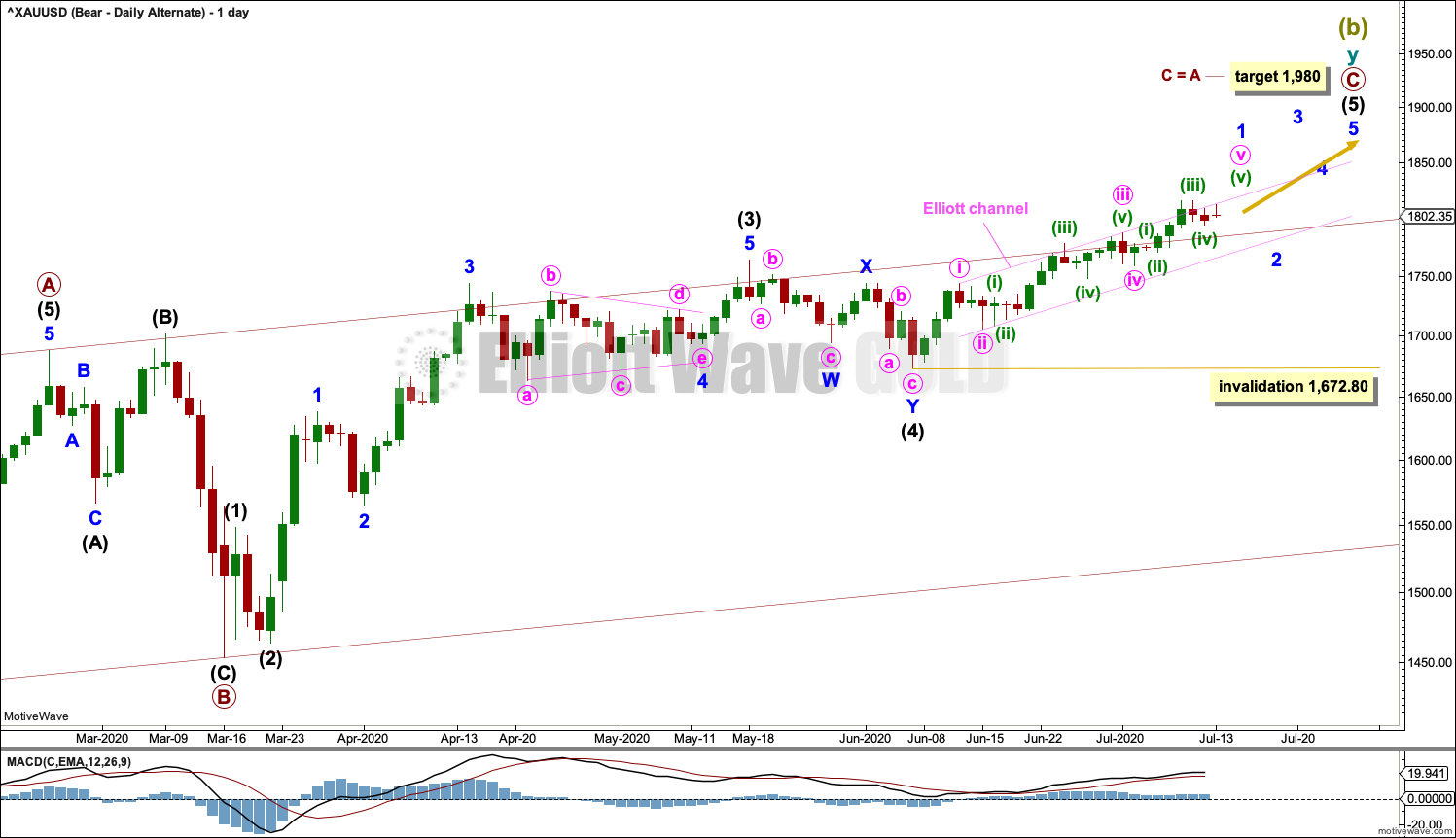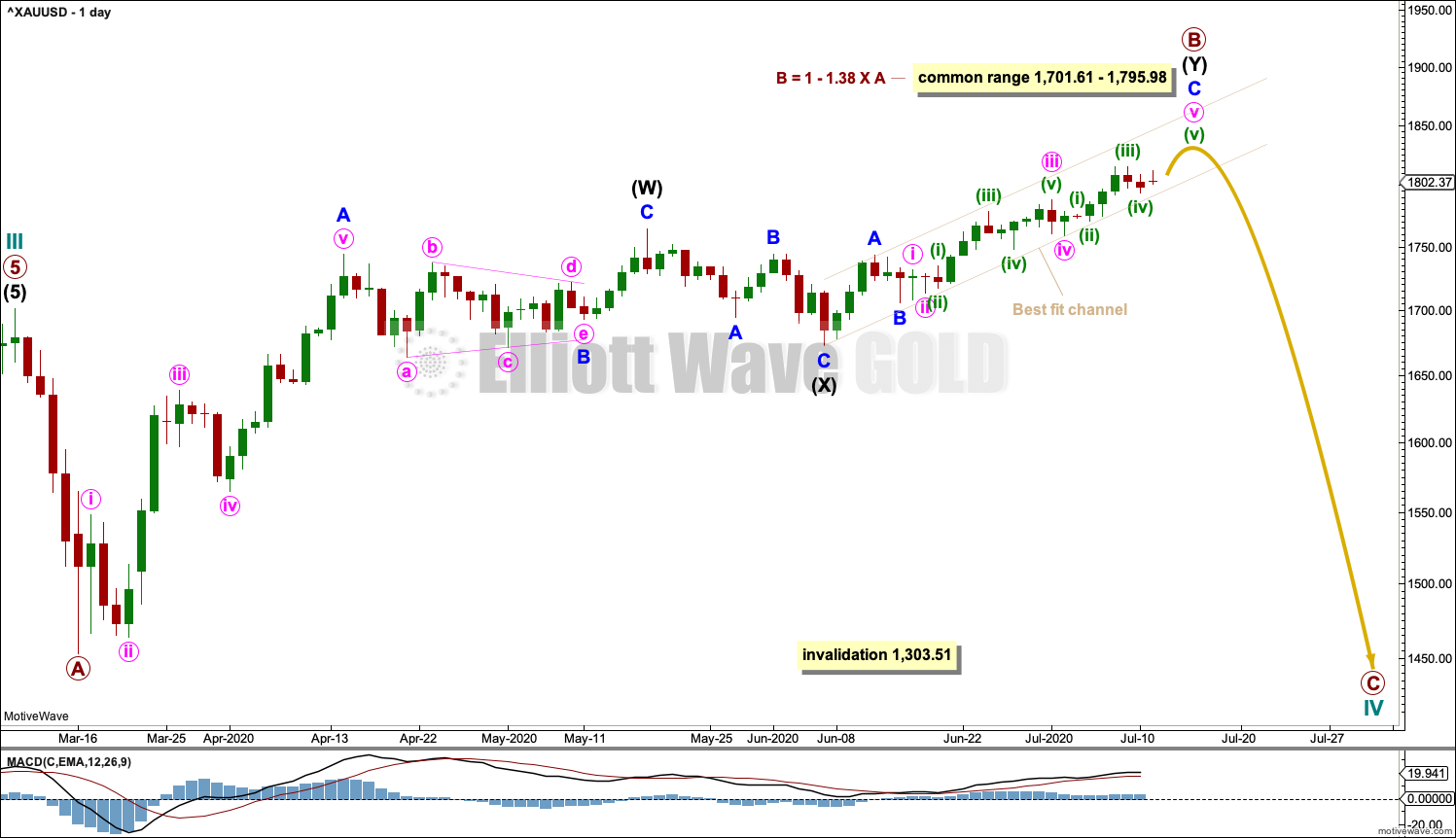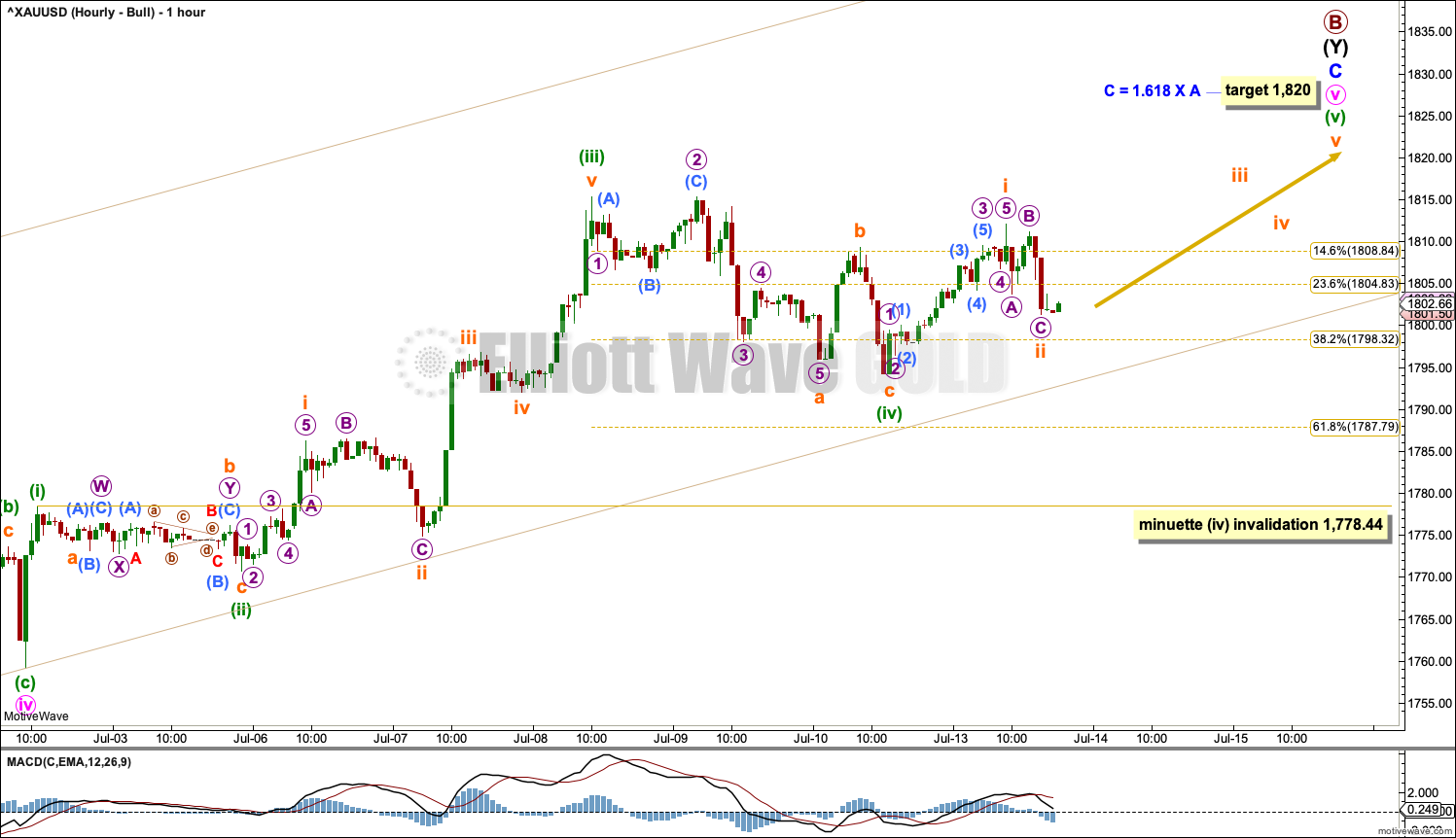GOLD: Elliott Wave and Technical Analysis | Charts – July 13, 2020
Price has back tested support at prior resistance and moved higher as expected from there.
Summary: The upwards trend remains intact. The next target is at 1,820 or 1,980.
Grand SuperCycle analysis is here.
Monthly charts were last updated here.
MAIN ELLIOTT WAVE COUNT
WEEKLY CHART
The bigger picture for this main bearish Elliott wave count sees Gold as still within a bear market, in a three steps back pattern that is labelled Grand Super Cycle wave IV on monthly charts.
Super Cycle wave (b) within Grand Super Cycle wave IV may be an incomplete double zigzag. When Super Cycle wave (b) may be complete, then this wave count expects Super Cycle wave (c) to begin and to move price below the end of Super Cycle wave (a) at 1,046.27.
The first zigzag in the double is labelled cycle wave w. The double is joined by a three in the opposite direction, a combination labelled cycle wave x. The second zigzag in the double is labelled cycle wave y.
The purpose of the second zigzag in a double is to deepen the correction. Cycle wave y has achieved this purpose.
No second wave correction within intermediate wave (5) may move beyond its start below 1,672.80.
We should always assume the trend remains the same until proven otherwise. At this stage, Gold is in a bull market for the mid term.
Two daily charts below label intermediate wave (5) in two different ways. Although they are labelled “main” and “alternate”, they may be about even in probability.
MAIN DAILY CHART
Minor waves 1 through to 4 within intermediate wave (5) may be complete. Minor wave 5 may be extending.
No second wave correction within minor wave 5 may move beyond the start of its first wave below 1,759.10.
Draw an Elliott channel about intermediate wave (5): draw the first trend line from the ends of minor waves 1 to 3, then place a parallel copy on the end of minor wave 2. Minor wave 5 may have the strength to break above the upper edge of this channel as fifth waves for commodities may be particularly strong.
HOURLY CHART
The hourly chart now shows the end of minor wave 4 and all of minor wave 5 so far.
Minor wave 5 may be unfolding as an impulse. Minute wave iii within minor wave 5 may only subdivide as an impulse. Minute wave iv may not move into minute wave i price territory below 1,778.44.
Minute wave ii was a shallow 0.40 zigzag. Minute wave iv may be a complete zigzag and slightly deeper at 0.47 of minute wave iii.
The target remains the same and expects minor wave 5 to be extended.
ALTERNATE DAILY CHART
This wave count is the same as the first main daily chart up to the low labelled intermediate wave (4). Thereafter, the degree of labelling within intermediate wave (5) is moved down one degree. It is possible that only minor wave 1 within intermediate wave (5) is nearing an end.
The channel is the same. Subdivisions at lower time frames are the same. The degree of labelling is the only difference.
Minor wave 2 may not move beyond the start of minor wave 1 below 1,672.80.
ALTERNATE BULLISH ELLIOTT WAVE COUNT
WEEKLY CHART
This wave count sees the the bear market complete at the last major low for Gold on 3 December 2015.
If Gold is in a new bull market, then it should begin with a five wave structure upwards on the weekly chart.
Cycle wave I fits as a five wave impulse with reasonably proportionate corrections for primary waves 2 and 4.
Cycle wave II fits as a double flat. However, within the first flat correction labelled primary wave W, this wave count needs to ignore what looks like an obvious triangle from July to September 2016 (this can be seen labelled as a triangle on the bear wave count above). This movement must be labelled as a series of overlapping first and second waves. Ignoring this triangle reduces the probability of this wave count in Elliott wave terms.
Within the first flat correction labelled primary wave W of the double flat of cycle wave II, intermediate wave (B) is 1.69 the length of intermediate wave (A). This is longer than the common range of up to 1.38, but within an allowable guideline of up to 2. The length of intermediate wave (B) reduces the probability of this wave count.
Cycle wave III may be complete. Cycle wave IV may not move into cycle wave I price territory below 1,303.51.
DAILY CHART
Cycle wave IV may be an incomplete expanded flat correction. Primary wave A within the flat correction may have subdivided as a zigzag. Primary wave B may be continuing higher as a double zigzag.
The common range of primary wave B would extend up to 1.38 times the length of primary wave A at 1,795.98. A maximum allowable guideline for primary wave B would be up to 2 times the length of primary wave A at 1,949.96. There is no Elliott wave rule stating a limit for B waves within expanded flat corrections, so there is no rule which may be used to determine an upper invalidation point for this wave count.
Primary wave B is now beyond the most common range, but remains within allowable limits. It may be over now with only one very slight new high.
The best fit channel about intermediate wave (Y) is slightly adjusted to contain recent lows. Assume upwards movement may continue while price remains within the channel. If the channel is breached, then assume intermediate wave (Y) may be over.
HOURLY CHART
Both wave counts now see an impulse continuing higher. Targets are different and the degree of labelling is different.
TECHNICAL ANALYSIS
WEEKLY CHART

Click chart to enlarge. Chart courtesy of StockCharts.com.
An upwards breakout has support from volume and a bullish signal from On Balance Volume.
A bearish upper wick and extreme ADX are warnings that this breakout may still be false, so a trend change may occur. Risk management during extreme conditions is essential.
DAILY CHART
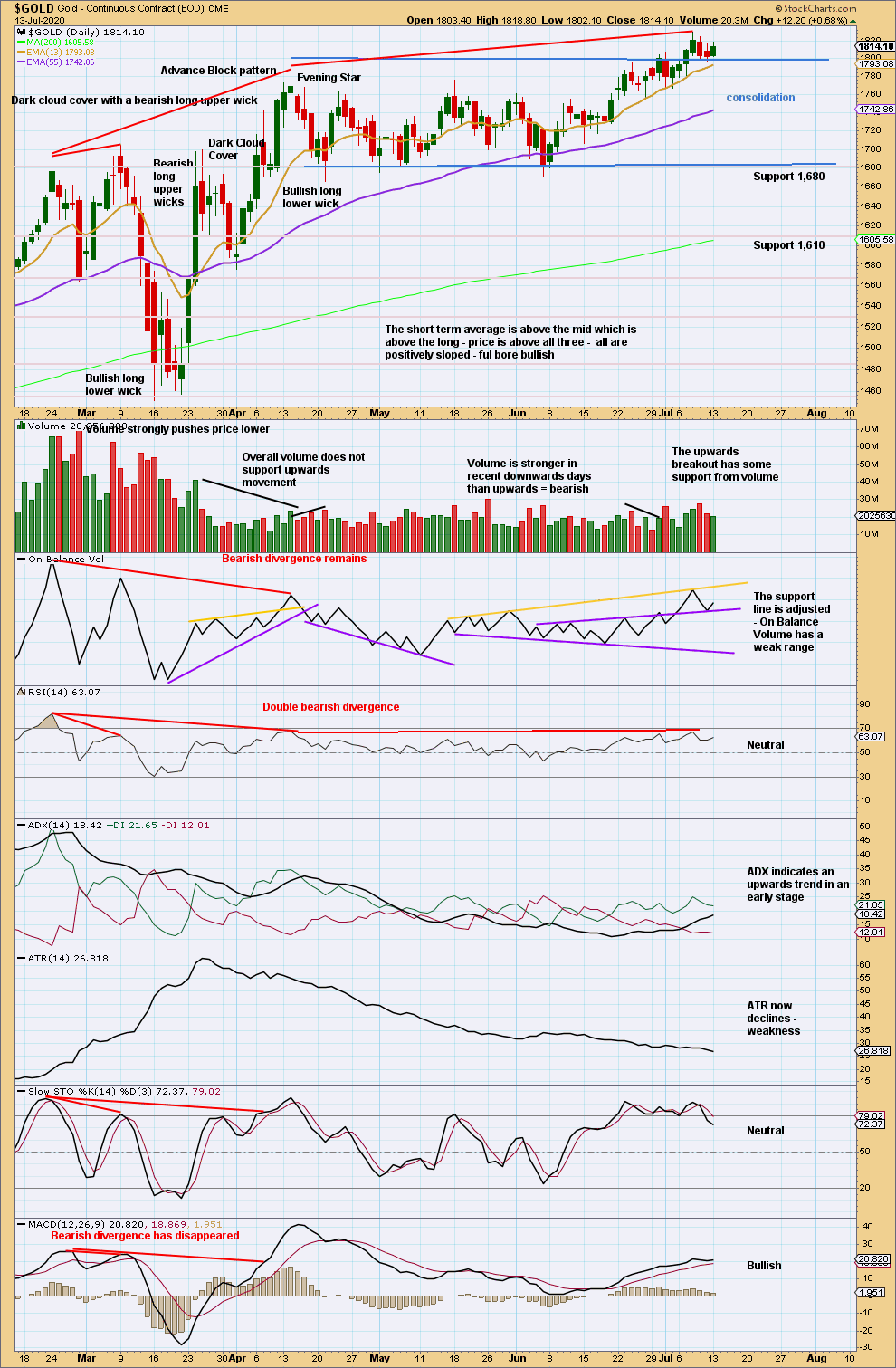
Click chart to enlarge. Chart courtesy of StockCharts.com.
The consolidation zone spans from resistance about 1,800 to support about 1,680.
An upwards breakout has some support from volume. Price has closed above resistance. A target calculated from the width of the consolidation is at 1,930.
RSI is not yet overbought. ADX is not extreme. There is room for this trend to continue.
Downwards movement following the breakout may be a back test of support at prior resistance. This is normal after a breakout. While price remains above support at the upper edge of the consolidation zone, the breakout looks most likely valid.
Longer term bearish divergence between price and RSI, with declining ATR, warn of weakness. This market is vulnerable to a potential trend change. Weak volume for Monday’s upwards session reinforces a warning here for bulls.
GDX WEEKLY CHART
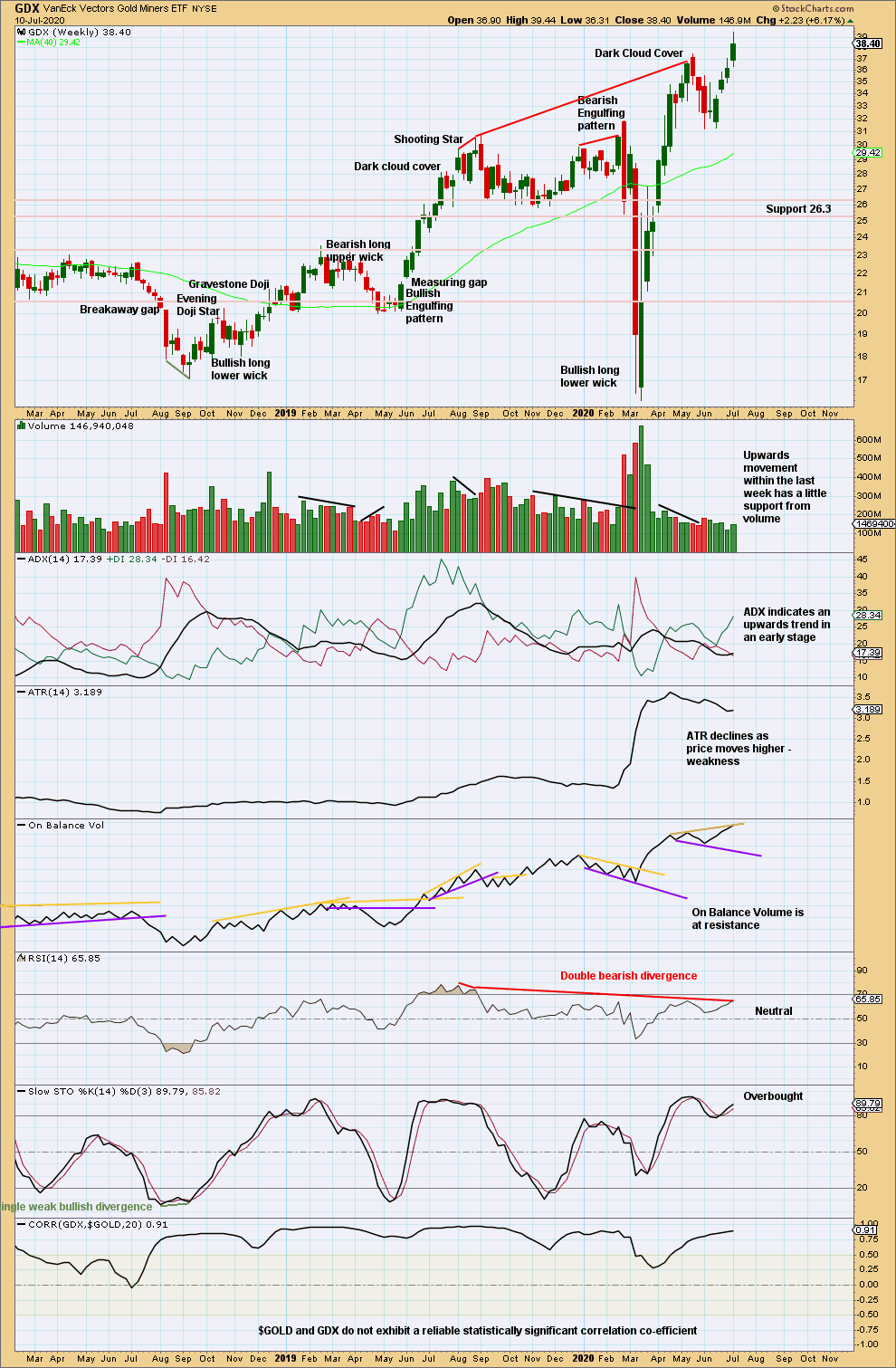
Click chart to enlarge. Chart courtesy of StockCharts.com.
Bearish divergence with RSI is a warning to proceed with caution.
GDX DAILY CHART

Click chart to enlarge. Chart courtesy of StockCharts.com.
Today price has closed back within the consolidation zone on a downwards day that has support from volume. The upwards breakout now looks to have been false. Price is again range bound.
Published @ 07:41 p.m. ET.
—
Careful risk management protects your trading account(s).
Follow my two Golden Rules:
1. Always trade with stops.
2. Risk only 1-5% of equity on any one trade.
—
New updates to this analysis are in bold.




